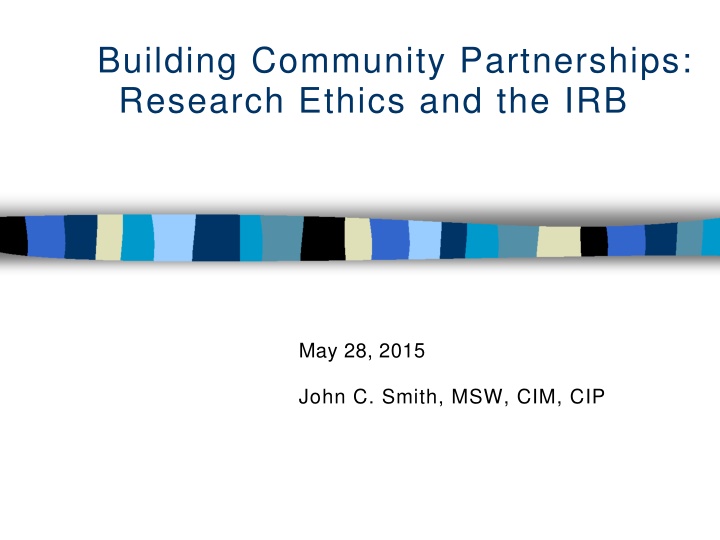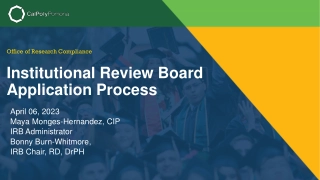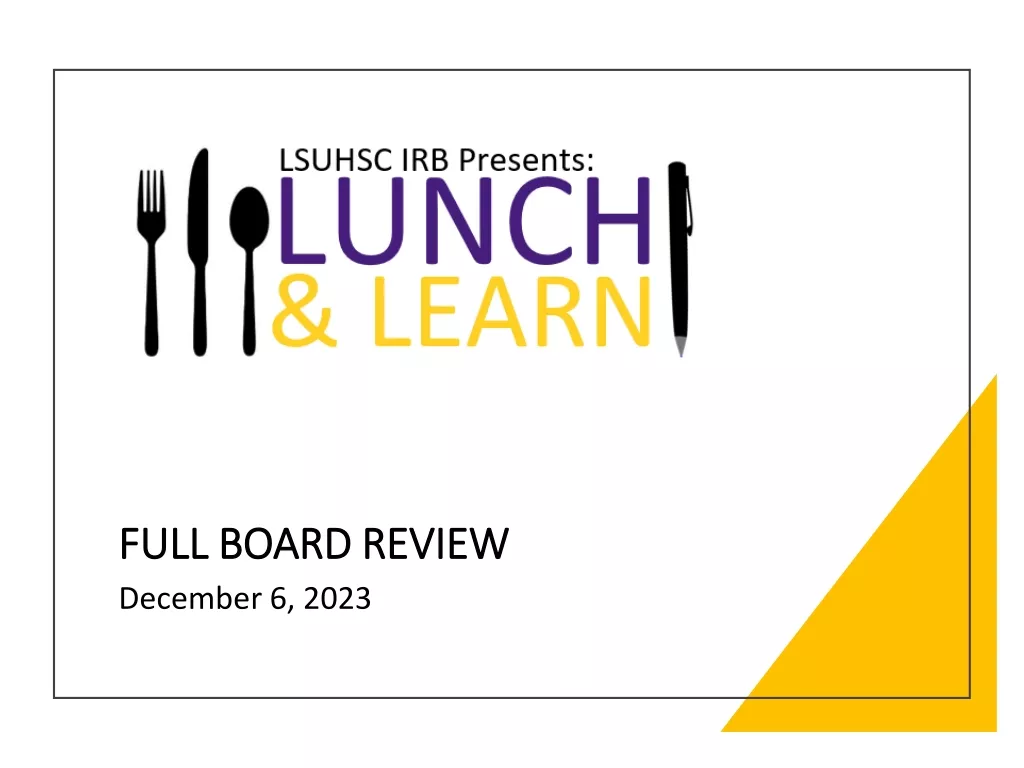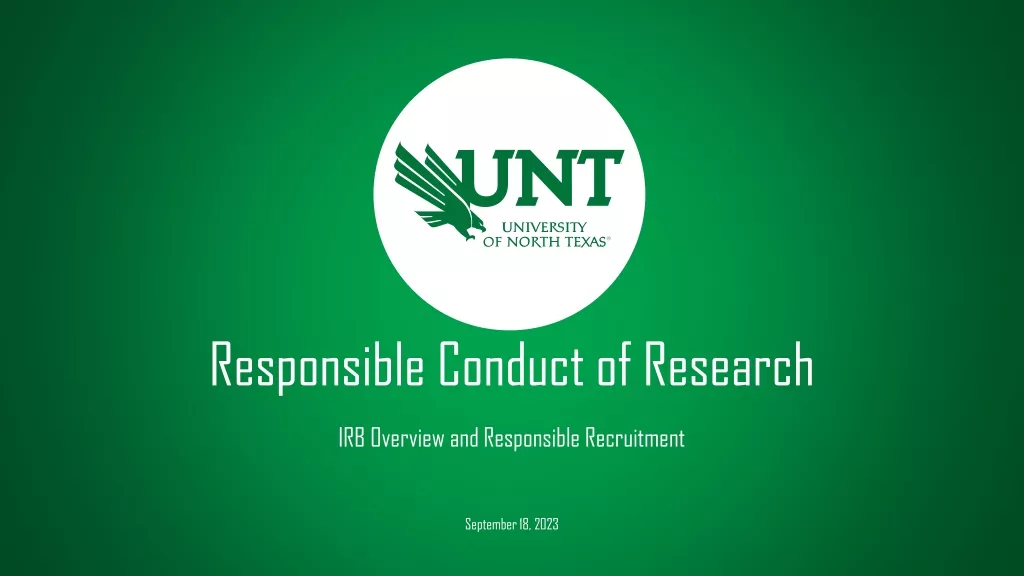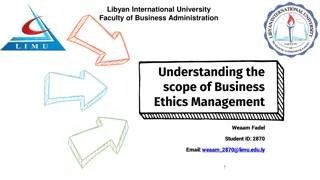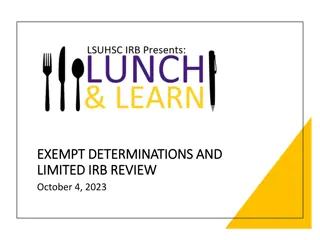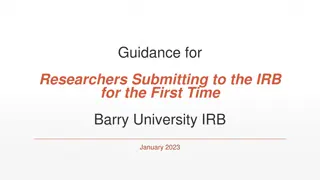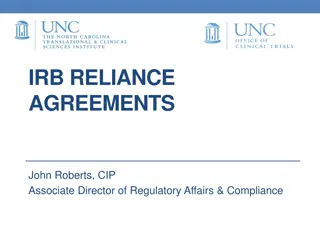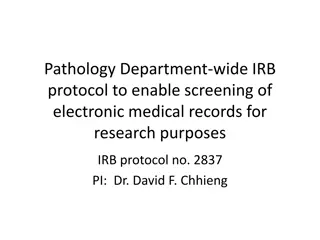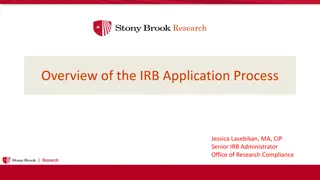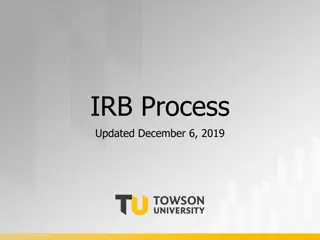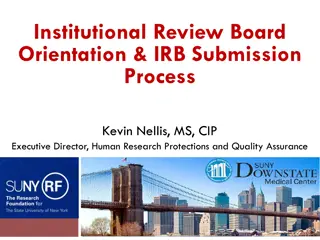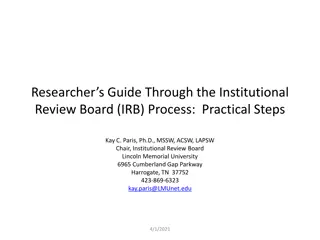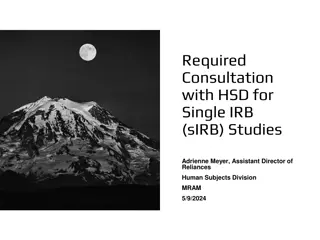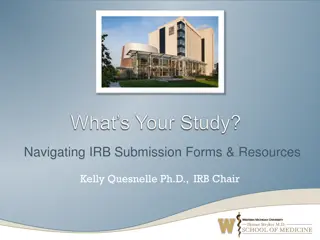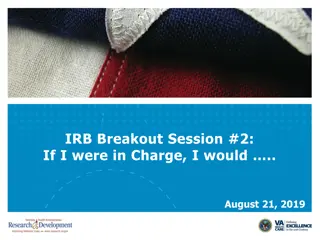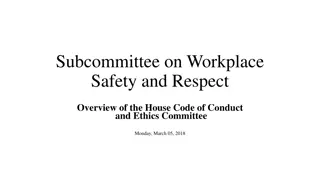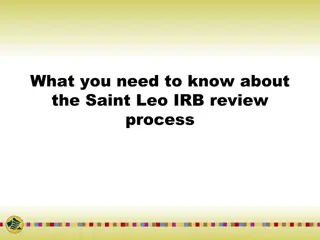Research Ethics and IRB Overview
In this article, we delve into the significance of Institutional Review Boards (IRBs) in research involving human participants. The role of IRBs, principles guiding their function, and the importance of ethical considerations are explored. The Belmont Report, which outlines key ethical principles, serves as a foundation for IRB evaluations to ensure the protection and welfare of research subjects.
Download Presentation

Please find below an Image/Link to download the presentation.
The content on the website is provided AS IS for your information and personal use only. It may not be sold, licensed, or shared on other websites without obtaining consent from the author.If you encounter any issues during the download, it is possible that the publisher has removed the file from their server.
You are allowed to download the files provided on this website for personal or commercial use, subject to the condition that they are used lawfully. All files are the property of their respective owners.
The content on the website is provided AS IS for your information and personal use only. It may not be sold, licensed, or shared on other websites without obtaining consent from the author.
E N D
Presentation Transcript
Building Community Partnerships: Research Ethics and the IRB May 28, 2015 John C. Smith, MSW, CIM, CIP
The most important task we face is learning to think in new ways -Gregory Bateson British Scientist & Author
What is an IRB? IRB is the acronym for Institutional Review Board for Human Participants. Any institution that receives federal funding to conduct research with human participants, such as Morehouse School of Medicine, is required to establish an IRB to review all research that directly or indirectly involves human participants, and to set forth institutional policy governing such research. Morehouse School of Medicine s IRB operates under a charge.
What is an IRB? The IRB for Human Participants has the authority to review, approve, disapprove or require changes in research or related activities involving human participants. Research reviewed by the IRB may also be subject to other review and approval or disapproval by officials at Morehouse School of Medicine. However, those officials may not approve research that has not been approved by the IRB for Human Participants. The IRB primary role is to ensure the protection of human participants as subjects of research at Morehouse School of Medicine.
Why are IRBs Important? The MSM IRB operates under the principles of The Belmont Report. The Belmont Report exists because of the unfortunate history of unethical research conducted on human subjects. It clearly explains the three principals that are the main tools that all IRB members should use to evaluate the ethics of specific research proposals. Respect for Persons is the first principle which mandates that subjects voluntarily consent to participate in research, that they are adequately and thoroughly informed about the research and what is required, and that their privacy and confidentiality are protected. Beneficence is the second principle which mandates the risks of research are justified by potential benefits to the individual or society and that those risks are minimized. Justice is the third and final principle which mandates the equitable distribution of risks and benefits among those who may benefit from the research, meaning that one subset of a population should not take on all the burden of risk and reap all of the rewards; risks and rewards should be applicable and available to all subsets of a community.
What does the IRB look for its review of a study application? The IRB evaluates every research protocol according to the ethical principles described in the Belmont Report (http://www.hhs.gov/ohrp/humansubjects/guidance/b elmont.html). Basically, this means the IRB considers whether the risks and benefits of a study are acceptable and managed appropriately, and whether individuals being asked to participate are adequately informed about the research and its possible risks.
What does the IRB look for its review of a study application? Considered another way, investigators are asked to look at their plans from the point of view of a research participant, or an observer concerned about responsible research. Who are the participants and how are they recruited? Could they be lured or coerced to participate? Is it through an institution that may have responsibilities toward them (e.g., a school or hospital) and should be consulted? Do they understand, in advance, what they are agreeing to participate in and give their consent willingly? What will they actually do, and what is done to them, during the study?
What does the IRB look for its review of a study application? Is it possible that the experience might be injurious, painful, uncomfortable, needlessly boring, embarrassing, offensive, or otherwise stressful? Might there be long- term consequences? Could the participant be endangered, compromised or embarrassed if information collected leaked out? There are many possible considerations, but they should not be difficult to understand if one assumes the participant's perspective. The IRB s role is to look at the study from this perspective and to ensure that proper precautions are taken to protect individuals when they agree to participate in research.
What are the IRB requirements for training? At Morehouse School of Medicine, all investigators and research staff must successfully complete the CITI Program for training in the ethical conduct of research with human participants and update it at least once every three years. Additionally, investigators and research staff must be qualified by training and experience for the research they will be conducting. It is important to understand that the responsibility for the welfare of participants lies with the principal investigator, even when participants have given consent.
What are the IRB requirements for training? Investigators and research staff must have the necessary training and expertise to o Ensure the rights, welfare and safety of participants are protected o Comply with regulations concerning IRB review and approval, including Informed consent requirements Reporting requirements Maintenance and retention of records (keep complete files during and 3 years after research ends) Supervise research conduct Apply relevant professional standards that are applicable to the research
Who is required to complete the human participants training? All faculty, students, and staff proposing to use human participants in research under the auspices of Morehouse School of Medicine are required to complete the human participants training. Approvals for including human participants in proposed research projects will be not be granted until this training has been completed and verified by the MSM IRB office.
How can I take the required training? You can access the human participant training online by going to www.citiprogram.org. The IRB may accept alternate training in lieu of the CITI training if the researcher can produce documentation related to the training course/s, the institution offering the training, the date of completion and the score received. Such documentation should accompany the proposal submission or be sent to the IRB office upon request. We also offer the lay, easy to understand CERTification Training for community members.
IRB COMPOSITION AND IRB MEMBER ROLES AND RESPONSIBILITIES 1. Overview Each IRB must be appropriately constituted for the volume and types of human research to be reviewed, in accordance with federal regulations. The IRBs will include members with diverse experience and expertise to assure the professional competence necessary to review the institution s research, as well as knowledge of community attitudes and training in protecting the rights and welfare of human subjects.
IRB COMPOSITION AND IRB MEMBER ROLES AND RESPONSIBILITIES 2. Definitions Affiliated: IRB membership status designating association with the institution Alternate: An individual appointed to the IRB to serve in the same capacity as the specific IRB member(s) for whom the alternate is named, who substitutes for the member at convened meetings when the member is not in attendance. Non- Scientist: An individual appointed to the IRB who (due to training, background, and/or occupation) is inclined to view research activities from the standpoint of someone outside the scientific or scholarly discipline of the IRB on which he/she serves.
IRB COMPOSITION AND IRB MEMBER ROLES AND RESPONSIBILITIES 3. IRB Composition A. In appointing IRB members, the Institutional Official (IO) and/or Vice President for Research will ensure that all of the following conditions are met for the university IRBs: IRB members will have varying backgrounds, experience, expertise, and professional competence as necessary to promote complete and adequate review of research activities commonly conducted by Morehouse School of Medicine s Human Research Protection Program Policies and Procedures.
IRB COMPOSITION AND IRB MEMBER ROLES AND RESPONSIBILITIES Each IRB will be sufficiently qualified through the experience, expertise, and diversity of its members, including considerations of race, gender, cultural backgrounds, and sensitivity to issues such as community attitudes, to promote respect for its advice and counsel in safeguarding the rights and welfare of human subjects
IRB COMPOSITION AND IRB MEMBER ROLES AND RESPONSIBILITIES Each IRB will include persons knowledgeable about institutional commitments and regulations, applicable laws, and standards of professional conduct and practices If the IRB regularly reviews research that involves a vulnerable category of participants, such as children, prisoners, pregnant women, or handicapped or mentally disabled persons, the IO will appoint one or more individuals who are knowledgeable about and experienced in working with these participants No IRB will consist entirely of men or entirely of women, and no appointment to the IRB is made solely on the basis of gender. No IRB will consist entirely of members of one profession
IRB COMPOSITION AND IRB MEMBER ROLES AND RESPONSIBILITIES Each IRB will include at least one member whose primary concerns are in scientific areas and at least one member whose primary concerns are in nonscientific areas. Each IRB will include at least one member who represents the perspective of research participants. Each IRB will include at least one member who is not otherwise affiliated with Morehouse School of Medicine and who is not part of the immediate family of a person affiliated with Morehouse School of Medicine Each IRB will consist of at least five members. For additional requirements for review of research involving prisoners, see HRPP policy [Research Involving Prisoners].
IRB COMPOSITION AND IRB MEMBER ROLES AND RESPONSIBILITIES The IRB may invite individuals with competence in special areas to assist in the review of protocols that require expertise beyond or in addition to that available on the IRB. These individuals (consultants) may not vote with the IRB. Other individuals also attend convened meetings as necessary. These individuals advise the IRB on the acceptability of proposed research in terms of regulatory requirements, institutional commitments, applicable laws.
WHAT IS A COMMUNITY MEMBER? An IRB community member is someone from outside the organization or institution. They come from a variety of backgrounds and are chosen for their particular experience, knowledge, or relationship to the types of studies reviewed by the IRB. These members often are drawn from the community in which an institution resides. They may be members of local clergy, interested volunteers, teachers, retirees, nurses or ethicists. Some are former research subjects. Others are interested in promoting research or are motivated by their concern about a particular disease or condition. The community member s perspective is usually non-scientific.
WHAT IS A COMMUNITY MEMBER? Because community members may not be affiliated with the institution, employees and retirees of the institution cannot serve as community members nor can their spouses. Although federal and state regulations do not use the term community member and instead refer to people in this position as non-affiliated members (meaning they are not directly associated with the institution) there is a historic interest in assuring that IRBs are mindful of community values.
HISTORY OF COMMUNITY MEMBERS ON IRBS In the wake of the most notable violations of human rights in the history of research, ethical codes for physician researchers were developed and oversight by ethics committees was established and became mandatory for human subjects research. So individuals outside of academic and medical research domains (community members) were included on these newly mandated committees. The most cited ethical lapses in human subjects research were the Nazi Doctors Medical Experiments in World War II and the Tuskegee Syphilis Study begun in 1930 on syphilitic black men in Alabama.
HISTORY OF COMMUNITY MEMBERS ON IRBS The Nazi Doctors medical experiments: After World War II, the world learned of the moral depravity of the 20 Nazi physicians who were convicted in Nuremberg, Germany for the part they played in the brutal human experiments at Nazi Death Camps. The moral lessons learned from the Nuremberg Trials were the need to limit human experimentation within strict moral, legal, and ethical boundaries and require voluntary consent of the human subject. The advancement of science alone is not an adequate goal when research compromises the safety and integrity of the human subject.
HISTORY OF COMMUNITY MEMBERS ON IRBS The Tuskegee Syphilis Study: For 40 years between 1932 and 1972, the U.S. Public Health Service (PHS) conducted research in Tuskegee, Alabama on 399 black men in the late stages of syphilis. These men mostly poor illiterate sharecroppers were never told that they had syphilis, never told of its seriousness, nor offered available cures. Informed that they were being treated for bad blood , their doctors never intended to cure them of syphilis.
HISTORY OF COMMUNITY MEMBERS ON IRBS The data for the experiment was to be collected from autopsies of the men, and they were thus deliberately left to suffer from the severe symptoms of this debilitating disease. Public outrage eventually ended this study and provided the impetus for the esteemed Belmont Report and subsequent federal human subjects protections and regulations. The PHS, which conducted the study, acknowledged in retrospect that the scientific peer review system did not address fundamental ethical issues.
Authentic Partnerships how do you know? All partners have power All partners have mission statements A common goal larger than any one partner Community partners are grounded in the community Institutional partners are committed to working with community partners Labonte R. (1997) Community, Community Development and the Forming of Authentic Partnerships: Some Critical Reflections. Chapter in Community Organizing & Community Building for Health. Minkler M ed. Rutgers University Press New Brunswick NJ. www.dictionary.reference.com
Partnerships include: An articulated vision Strategic outreach and membership development Ground rules Structure and operating procedures New modes of communication Leadership opportunities for everyone Activities that are culturally sensitive Wolff T, Kaye G. (1995) From the Ground Up: A workbook on Coalition Building and Community Development. Amherst Mass: AHEC/Community Partners. pp. 54-55, 69
Moving Partnership into Research: CPER
Whats Different? Present & Future Past Little community education about research only when university wants to recruit participants Educating the community about research beyond recruiting University inviting the community to partner Community had to knock on university door for help Meetings held in the community or compensated for parking if meeting held on campus Meetings held on campus University determines community needs Community determines community need Benefits shared. Community partners present, prepare manuscripts, & are acknowledged University benefited from research University holds money & resources Sharing money & resources The partnership says and shared decision-making University says and determines
